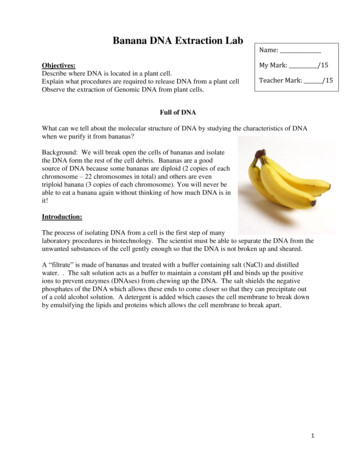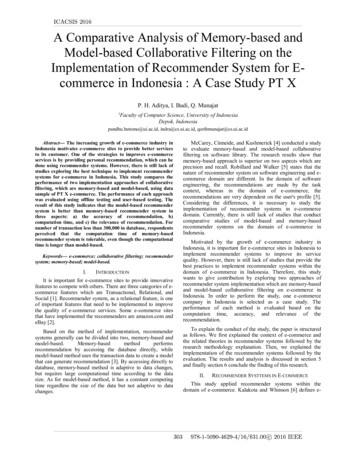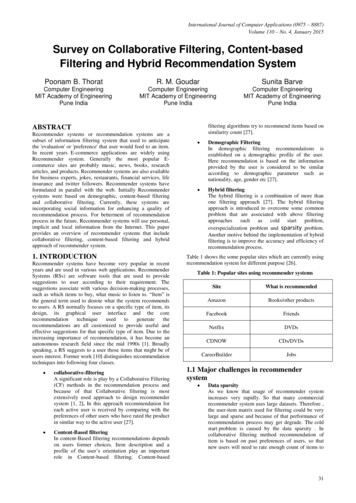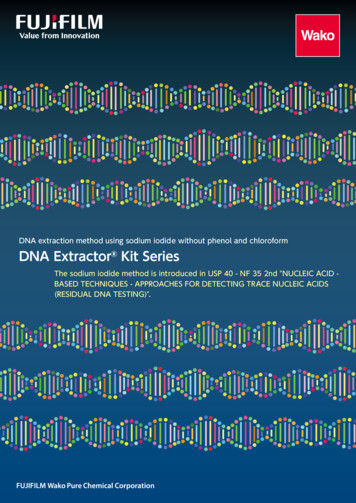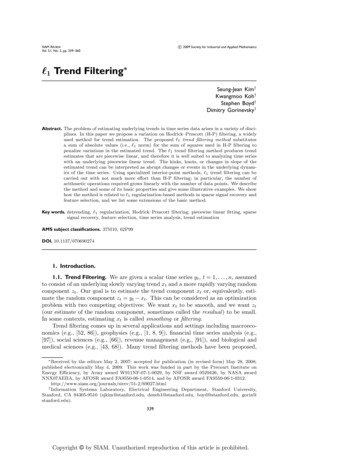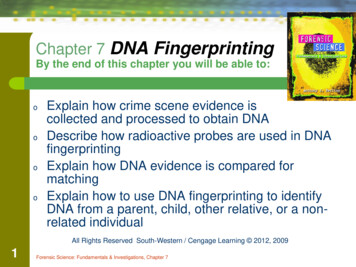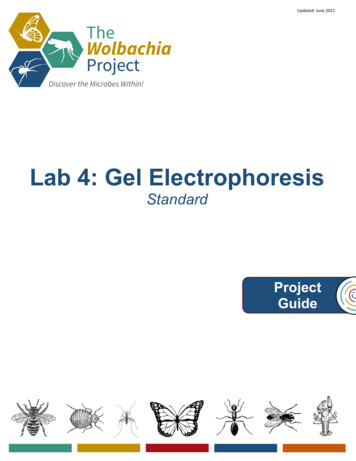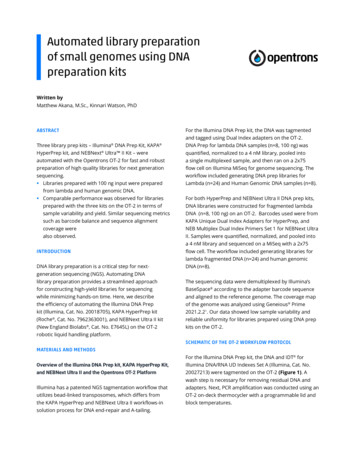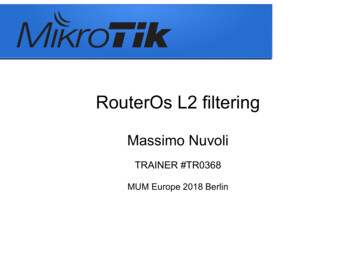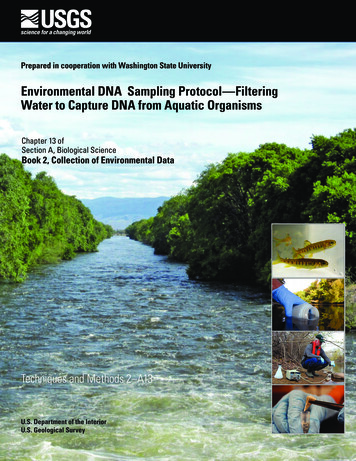
Transcription
Prepared in cooperation with Washington State UniversityEnvironmental DNA Sampling Protocol—FilteringWater to Capture DNA from Aquatic OrganismsChapter 13 ofSection A, Biological ScienceBook 2, Collection of Environmental DataTechniques and Methods 2–A13U.S. Department of the InteriorU.S. Geological Survey
Cover: Okanogan River, British Columbia, Canada, 2012.Insets from top to bottom:Juvenile rainbow trout from Ratz Creek, Alaska, 2009. (C)2009 ADF&G, Division of Sport Fish. Used with permission.Collecting eDNA sample from Boise River, Boise, Idaho, 2011.USGS Technician Kevin Glueckert collects eDNA sample from Boise River, Boise, Idaho, 2014.Preserving folded eDNA sample in ethanol vial-filled vial, 2012.Photographs by Matthew B. Laramie, U.S. Geological Survey, unless otherwise noted.
Environmental DNA Sampling Protocol—Filtering Water to Capture DNA fromAquatic OrganismsBy Matthew B. Laramie, David S. Pilliod, Caren S. Goldberg, andKatherine M. StricklerChapter 13 ofSection A, Biological ScienceBook 2, Collection of Environmental DataPrepared in cooperation with Washington State UniversityTechniques and Methods 2–A13U.S. Department of the InteriorU.S. Geological Survey
U.S. Department of the InteriorSALLY JEWELL, SecretaryU.S. Geological SurveySuzette M. Kimball, Acting DirectorU.S. Geological Survey, Reston, Virginia: 2015For more information on the USGS—the Federal source for science about the Earth, its natural and livingresources, natural hazards, and the environment—visit http://www.usgs.gov or call 1–888–ASK–USGS.For an overview of USGS information products, including maps, imagery, and publications,visit http://www.usgs.gov/pubprod/.Any use of trade, firm, or product names is for descriptive purposes only and does not imply endorsement by theU.S. Government.Although this information product, for the most part, is in the public domain, it also may contain copyrighted materialsas noted in the text. Permission to reproduce copyrighted items must be secured from the copyright owner.Suggested citation:Laramie, M.B., Pilliod, D.S., Goldberg, C.S., and Strickler, K.M., 2015, Environmental DNA sampling protocol—Filtering water to capture DNA from aquatic organisms: U.S. Geological Survey Techniques and Methods, book 2,chap. A13, 15 p., http://dx.doi.org/10.3133/tm2A13.ISSN 2328-7055 (online)
iiiContentsAbstract.1Introduction.1Contamination Prevention.2Selecting the Best Protocol for Your Sample Sites.2Protocol #1: Manual, Hand-Driven Vacuum Pump.4Protocol #2: Rechargeable Cordless Driver/Drill with Peristaltic Pump Head .7Protocol #3: 120-V AC Motor with Peristaltic Pump Head.10Acknowledgments.13References Cited.13Appendix A. Suggested Supplies List for Environmental DNA Sampling.15
ivConversion FactorsInch/Pound to International System of UnitsMultiplyByTo obtainLengthinch (in.)25.4millimeter (mm)Volumeounce, fluid (fl. oz)0.02957liter (L)International System of Units to Inch/PoundMultiplyByTo obtainLengthmillimeter (mm)micrometer (µm)0.039373.93700787 10-5inch (in.)inch (in.)Volumeliter (L)milliliter (mL)33.820.03381402ounce, fluid (fl. oz)ounce, fluid (fl. oz)
Environmental DNA Sampling Protocol—FilteringWater to Capture DNA from Aquatic OrganismsBy Matthew B. Laramie1, David S. Pilliod1, Caren S. Goldberg2, and Katherine M. Strickler2AbstractEnvironmental DNA (eDNA) analysis is an effectivemethod of determining the presence of aquatic organismssuch as fish, amphibians, and other taxa. This publication ismeant to guide researchers and managers in the collection,concentration, and preservation of eDNA samples from lenticand lotic systems. A sampling workflow diagram and threesampling protocols are included as well as a list of suggestedsupplies. Protocols include filter and pump assembly using:(1) a hand-driven vacuum pump, ideal for sample collectionin remote sampling locations where no electricity is availableand when equipment weight is a primary concern; (2) aperistaltic pump powered by a rechargeable battery-operateddriver/drill, suitable for remote sampling locations whenweight consideration is less of a concern; (3) a 120-voltalternating current (AC) powered peristaltic pump suitablefor any location where 120-volt AC power is accessible,or for roadside sampling locations. Images and detaileddescriptions are provided for each step in the sampling andpreservation process.IntroductionOrganisms produce an abundance of genetic materialthat can persist in aquatic environments as environmentalDNA (eDNA) when expelled from the organism in the formof sloughed cells, feces, or other exogenous processes. Thecollection, concentration, and analysis of eDNA from watersamples is an effective method of determining the presenceof aquatic organisms such as fish (Jerde and others, 2011;Takahara and others, 2013; Laramie and others, 2014),amphibians (Ficetola and others, 2008; Goldberg and others,2011; Pilliod and others, 2013a), and other taxa (Thomsen andothers, 2012). For an overview of early (2008–11) methodsand applications of eDNA, see Pilliod and others (2013b).U.S. Geological Survey.12Washington State University, School of the Environment.This publication is meant to serve as a guide forcollection, concentration, and preservation of eDNA samplesfrom lentic and lotic systems and to provide three samplingprotocols and a list of necessary supplies similar to those usedin past studies (Goldberg and others, 2011, 2013; Pilliod andothers, 2013a; Laramie and others, 2015). These protocolshave been used to reliably and consistently collect andconcentrate eDNA from stream samples. However, adaptationsto these protocols may be necessary, depending on target taxaor environmental conditions of the system being sampled. Theprotocols included in this document use cellulose nitrate filtermembranes with a 0.45-μm pore diameter (see appendix Afor supplies list) for water samples ideally ranging from250 to 1,000 mL. Samples collected from streams or pondswith an abundance of impurities such as tannins and organicmaterials likely will be limited to 500 mL or less, using thedescribed filter type. Filters with a greater pore diameter(from 0.45 to more than 3.0 μm) could reduce clogging of thefilter, increasing the sample volume, when desired. Turnerand others (2014) provides an isocline equation to calculateeDNA collection equivalents for various pore sizes andsample volumes using carp as a model organism. Essentially,greater pore sizes allow for filtration of greater volumes ofwater, but eDNA molecules could potentially pass throughthe filter without being collected. Examination of literatureor empirical testing may be necessary to determine the mostsuitable materials for desired applications. Additionally,researchers also must consider the ecology of the targetorganism and the characteristics of the water body beingsampled to determine the most suitable locations within abody of water to collect water samples (for example, streammargins or thalweg). Whenever possible, samples should becollected without entering a stream or pond to reduce theprobability of contaminating the site, boots and clothing, and(or) sampling equipment.
2 Environmental DNA Sampling Protocol—Filtering Water to Capture DNA from Aquatic OrganismsContamination PreventionContamination can result from various factorsat every step in the sample collection process.Be vigilant. Before initiating eDNA samplecollection, the following field and laboratorypractices should be reviewed to avoidcontamination of samples and cross-contaminationamong samples:Selecting the Best Protocol for YourSample SitesDepending on the characteristics of your sample sites,samples can be collected and filtered in a variety of ways. Adecision tree is provided to help you select the proper protocolbefore beginning.Are you sampling inremote locations, awayfrom an electrical powersource (120-V AC outlet,vehicle battery)? Wear clean, non-powdered, single-use gloveswhen collecting samples and removing filters.Do not let gloves contact contaminatedsurfaces, such as any equipment that was notsterilized between sites, prior to handlingthe filter. Be careful with gloves and other supplies. Donot leave them unprotected and do not tossthem in a backpack. Keep everything cleanand in separate plastic bags, which should bediscarded and replaced any time contaminationis suspected. Open filter funnel package from bottom (stemend) and keep closed between sites. Be carefulnot to touch inside the filter funnel whenremoving it from its package. Decontaminate forceps between each sampleby soaking in 50 percent commercial bleachfor at least 1 minute. Rinse well with distilledwater. To re-use grab bottles, decontaminate bysubmerging in 50 percent bleach solutionand rinse thoroughly with distilled water (forexample, fill, cap, shake, and rinse; repeat atleast three times), let dry. At the sampling site,rinse again with sample water three times (capand shake) to remove any remaining bleachbefore collecting sample. If it is necessary to enter the water at asampling site, rubber boots should be used andmust be decontaminated between sites. Removeall dirt, pebbles, and other environmental debrisfrom soles and sides of boots. Decontaminatein 50 percent commercial bleach and rinse wellwith distilled water (or tap water, if necessary). If sampling a stream, collect sample upstreamof your standing location to reduce potentialcontamination by boots, clothing, orequipment.YESIs the weight ofsamplingequipment aprimary concern?YESUse Protocol #1:Manual handpumpNOUse Protocol #3:120-V ACperistaltic pumpNOUse Protocol #2:Pump head withrechargeablecordlessdriver/drillEssentially, if working in remote locations without access toelectricity or when the weight of your sampling equipment isa primary concern, we recommend Protocol #1, which uses alightweight hand-driven vacuum pump. If you are willing tocarry a rechargeable cordless driver/drill and a peristaltic pumphead when working in remote locations, then we recommendProtocol #2. If your sample sites are near an electrical powersource (vehicle battery) or if you prefer to collect the samples andthen transport them to a centralized location near a power source,we recommend Protocol #3, which uses an 120-V AC motor unitwith a peristaltic pump head.
Selecting the Best Protocol for Your Sample Sites 3Sampling Workflow DiagramStep 1: Choose the best protocol, depending on your conditionsProtocol #1: Hand pumpProtocol #2: Cordless driverProtocol #3: 120-V pumpStep 2: Collect water sampleorDirectCollect and pourThe filtering procedure and filterpaper preservation are essentiallythe same regardless of whichsampling protocol is selected; onlythe configuration and assembly ofthe pump/filter differ. The samplingworkflow diagram illustrates that,with all three protocols, watersamples may be collected either bydirectly submerging the filter funnel(connected to a length of siliconetubing) into the stream or pond withthe pump engaged or by using asterile collection bottle (for example,a Nalgene bottle) or sterile samplebag (for example, Whirl-Pak ) to grabthe sample from the stream or pondand pour it into the filter funnel withthe pump engaged. Filter preservationis identical for all provided protocolsand variations. Specifics for suggestedpump options are listed in table 1.Suggested supplies list and vendorcontact information are provided inappendix A.Step 3: Preserve water sampleEthanol-filled vialTable 1. Suggested pump options for filtering environmental DNA samples.[Environmental DNA (eDNA) sampling supplies manufacturer information is available in appendix A. Abbreviations: V, volt; AC, alternating current;DC, direct current; N/A, not applicable]ProtocolPowerPump/motorPump headTubingProtocol #1:Manual, hand-drivenvacuum pumpManual, hand operatedHand-driven vacuumpumpNAMasterflex platinumcured silicon tubing,L/S 15Protocol #2:Rechargeable cordlessdriver with peristalticpump headRechargeable batterypoweredCordless, handhelddriver with standardflathead drillbitMasterflex L/SStandard Pump Headfor L/S 15 tubingMasterflex platinumcured silicon tubing,L/S 15Protocol #3:120-V AC motor withperistaltic pump head120-V AC (or 12-V DC,with power inverter)Masterflex L/SEconomy VariableSpeed Drive MotorMasterflex L/SStandard Pump Headfor L/S 15 tubingMasterflex platinumcured silicon tubing,L/S 15
4 Environmental DNA Sampling Protocol—Filtering Water to Capture DNA from Aquatic OrganismsProtocol #1: Manual, Hand-Driven Vacuum PumpThis configuration requires no electricity and is most useful when working in remote sampling locations and when weight ofsampling equipment is a primary concern. A hand-driven vacuum pump and filter assembly is shown in figure 1.1. Numbers inparenthesis in assembly instructions indicate parts shown in figure 1.1.Figure 1.1. Necessary equipment: 1, filter funnel; 2, #8 FisherbrandTM rubber stopper; 3, NalgeneTM vacuum flask; 4, Masterflex L/S 15silicone tubing; 5, NalgeneTM hand-operated vacuum pump. Note: See appendix A for manufacturer’s information.Part 1. Pump and Filter Assembly1. Seat rubber stopper (2) into top of vacuum flask (3), pressing to ensure a good seal.2. Attach hand-driven vacuum pump (5) to tube connector on vacuum flask using section of silicone tubing (4). The vacuumflask allows for measurement of sample volume.3. Secure filter funnel (1) to adapter stem.4. If collecting samples directly from stream or pond: attach disposable filter funnel to rubber stopper using an appropriatelength of silicone tubing by inserting one end of tubing into filter funnel adapter stem and the other end of tubing into hole inrubber stopper atop the vacuum flask, creating an airtight seal at both ends.orIf first collecting samples in separate, sterile collection bottle or Whirl-Pak : attach disposable filter funnel directly torubber stopper by inserting adapter stem into hole in stopper, creating an airtight seal. Samples must then be poured intofilter funnel for filtration.
Protocol #1 5Part 2. Filtration and Filter PreservationFiltration and Filter PreservationDepending on your needs, water samples can be collectedin two ways: (1) Directly; by submerging the filter funneldirectly into the stream or pond with the pump engaged, or(2) Grab and pour; by collecting the water sample in aseparate, sterile collection bottle (for example a Nalgene bottle or Whirl-Pak ) and then pouring it into the filter funnel,with the pump engaged.1. Assemble filter funnel and pump as described in Part 1.Supplies needed (figs. 1.2 and 1.3): single-use gloves50 percent bleach solutiondistilled rinse water2.0 mL vials three-fourths filled with undiluted moleculargrade ethanol (denatured ethanol will destroy the sample) forceps ethanol-proof marker optional: sterile Nalgene collection bottle or Whirl-Pak .2. If collecting sample directly from the stream or pond:wearing clean gloves, collect 1 L (or desired volume) ofstream or pond water by submerging the filter funnel (fig.1.4) directly into the stream or pond surface with the pumpengaged to filter the desired amount of water. Pre-markingthe vacuum flask at the intended sample volume (forexample, 1 L) is necessary to ensure consistent samplecollection.orIf first collecting sample in separate, sterile collectioncontainer: wearing clean gloves, collect desired volume(generally, 250–2,000 mL) of stream or pond water bypartially submerging a sterile Nalgene bottle (fig. 1.5)or sterile Whirl-Pak into the water surface. Slowly poursample from Nalgene bottle or Whirl-Pak into filterfunnel (250 mL at a time) with pump engaged. Pauseseveral times to swirl water in Nalgene or Whirl-Pak before pouring remaining water into funnel. Duringfiltering, make sure vacuum pressure is sustained to ensurethat water is flowing unidirectionally from the funnel to thevacuum flask.Figure 1.2. Sampling supplies.Figure 1.4. Filter funnel being submerged directly into streamwith pump engaged to begin filtration.Figure 1.3. Optional supplies.Figure 1.5. Sterile Nalgene collection bottle being submergedin stream to collect desired volume of water. Sample must thenbe poured into filter funnel (250 milliliters at a time) with pumpengaged to begin filtration.
6 Environmental DNA Sampling Protocol—Filtering Water to Capture DNA from Aquatic Organisms3. Disinfect forceps by soaking in 50 percent bleach solutionfor at least 1 minute and rinsing thoroughly in distilledwater stored in a sterile container (for example, 50 mLcentrifuge tube).4. Disconnect top and bottom units of the filter funnel toexpose the filter membrane (fig. 1.6).Figure 1.8. Folded filter being placed into 2.0 milliliter vial filled with200 proof molecular grade ethanol for preservation.6. Ensure that vial is labeled properly.7. Remove filter funnel from rubber stopper.Figure 1.6. Disconnected top and bottom units of filter funneland exposed filter membrane.5. Using decontaminated forceps, fold filter paper in onehalf four times (fig. 1.7). Keep filter stable and prevent itfrom unfolding by using gloved finger (change gloves firstif glove has come into contact with anything except thestream or decontaminated equipment). Place folded filterin vial filled with 200-proof, molecular-grade ethanol forpreservation and storage (fig. 1.8).Figure 1.7. Method for folding filter paper inone-half four times using sterile forceps andclean gloves.8. Recycle plastic funnel when recycling is available.Do not reuse.9. Discharge water can be poured back into stream, oncesample collection is complete (if vacuum flask wasdecontaminated after previous use).10. Store vials in a cool place away from light exposure.
Protocol #2 7Protocol #2: Rechargeable Cordless Driver/Drill with Peristaltic Pump HeadThis configuration is most useful when working in remote locations when the ease of sampling takes precedence over the weightof the sampling gear. A peristaltic pump head driven by a rechargeable cordless driver/drill and filter assembly is shown in figure2.1. Numbers in parenthesis in assembly instructions indicate parts shown in figure 2.1.Figure 2.1. Necessary equipment: 1, filter funnel; 2, Masterflex L/S 15 silicone tubing; 3, Masterflex standard pump head for L/S 15 tubing(shown mounted to piece of plastic); 4, NalgeneTM vacuum flask; 5, battery‑operated driver/drill. Note: See appendix A for manufacturer’sinformation.Part 1. Pump and Filter Assembly1. Run a section of tubing (2) through peristaltic pump head (3) and insert outflow end of tubing into a discharge bottle (4).A vacuum flask with desired volume marked on side (open, without vacuum) can be used as a means to measure dischargewater so the amount of water pumped through the filter can be recorded.2. Secure a filter funnel (1) to adapter stem.3. Attach sterilized tubing (2) to filter funnel/adapter stem by inserting tubing into stem, creating airtight seal.4. Engage the peristaltic pump head by driving it with the cordless driver/drill (5) using a standard flathead bit. Ensure thatthere is enough room beneath the pump head to allow for unrestricted rotation of the mechanism on the underside of theunit. As in figure 2.1, it may be useful to mount it to a piece of plastic or wood for this purpose.
8 Environmental DNA Sampling Protocol—Filtering Water to Capture DNA from Aquatic OrganismsPart 2. Filtration and Filter PreservationFiltration and Filter PreservationDepending on your needs, water samples can be collected intwo ways: (1) Directly; by submerging the filter funnel directlyinto the stream or pond with the pump engaged, or (2) Graband pour; by collecting the water sample in a separate, sterilecollection bottle (for example a Nalgene bottle or WhirlPak ) and then pouring it into the filter funnel, with the pumpengaged.1. Assemble filter funnel and pump as described in Part 1.Supplies needed (figs. 2.2 and 2.3): single-use gloves50 percent bleach solutiondistilled rinse water2.0 mL vials three-fourths filled with undiluted moleculargrade ethanol (denatured ethanol will destroy the sample) forceps ethanol-proof marker optional: sterile Nalgene collection bottle or Whirl-Pak .2. If collecting sample directly from the stream or pond:wearing clean gloves, collect 1-L (or desired volume) ofstream or pond water by submerging the filter funnel (fig.2.4) directly into the stream or pond surface with the pumpengaged to filter the desired amount of water. Pre-markingthe vacuum flask at the intended sample volume (forexample, 1 L) is necessary to ensure consistent samplecollection.orIf first collecting sample in separate, sterile collectioncontainer: wearing clean gloves, collect desired volume(generally, 250–2,000 mL) of stream or pond water bypartially submerging a sterile Nalgene bottle (fig. 2.5)or sterile Whirl-Pak into the water surface. Slowly poursample from Nalgene bottle or Whirl-Pak into filterfunnel (250 mL at a time) with pump engaged. Pauseseveral times to swirl water in Nalgene or Whirl-Pak before pouring remaining water into funnel. Duringfiltering, make sure vacuum pressure is sustained to ensurethat water is flowing unidirectionally from the funnel to thevacuum flask.Figure 2.2. Sampling supplies.Figure 2.4. Filter funnel being submerged directly into streamwith pump engaged to begin filtration.Figure 2.3. Optional supplies.Figure 2.5. Sterile Nalgene collection bottle being submergedin stream to collect desired volume of water. Sample must thenbe poured into filter funnel (250 milliliters at a time) with pumpengaged to begin filtration.
Protocol #2 93. Disinfect forceps by soaking in 50 percent bleach solutionfor at least 1 minute and rinsing thoroughly in distilledwater stored in a sterile container (for example, 50 mLcentrifuge tube).4. Disconnect top and bottom units of the filter funnel toexpose the filter membrane (fig. 2.6).Figure 2.8. Folded filter being placed into 2.0 milliliter vial filled with200 proof molecular grade ethanol for preservation.Figure 2.6. Disconnected top and bottom units of filter funneland exposed filter membrane.5. Using decontaminated forceps, fold filter paper in onehalf four times (fig. 2.7). Keep filter stable and prevent itfrom unfolding by using gloved finger (change gloves firstif glove has come into contact with anything except thestream or decontaminated equipment). Place folded filterin vial filled with 200-proof, molecular-grade ethanol forpreservation and storage (fig. 2.8).Figure 2.7. Method for folding filter paper inone-half four times using sterile forceps andclean gloves.6. Ensure that vial is labeled properly.7. Remove filter funnel from rubber stopper.8. Recycle plastic funnel when recycling is available.Do not reuse.9. Discharge water can be poured back into stream, oncesample collection is complete (if vacuum flask wasdecontaminated after previous use).10. Store vials in a cool place away from light exposure.
10 Environmental DNA Sampling Protocol—Filtering Water to Capture DNA from Aquatic OrganismsProtocol #3: 120-V AC Motor with Peristaltic Pump HeadThis configuration is most useful when sampling near an electrical power source (e.g. vehicle battery) or if you prefer to collectthe samples and transport them to a centralized location near a power source prior to filtration. A 120-V AC motor unit withattached peristaltic pump head and filter assembly is shown in figure 3.1. Numbers in parenthesis in assembly instructionsindicate parts shown in figure 3.1.Figure 3.1. Necessary equipment: 1, filter funnel; 2, Masterflex L/S 15 silicone tubing; 3, 120-V Masterflex L/S economy variable speeddrive motor; 4, Masterflex standard pump head for L/S 15 tubing; 5, NalgeneTM vacuum flask. Note: See appendix A for manufacturer’sinformation.Part 1. Pump and Filter Assembly1. Connect peristaltic pump head (4) to 120-V AC motor (3) using supplied bolts.2. Run tubing (2) through peristaltic pump head (4) and insert outflow end of tubing into discharge bottle (5). A vacuum flaskwith desired volume marked on side (open, without vacuum) can be used as a means to measure discharge water so theamount of water pumped through the filter can be recorded. Discharge water container does not need to be sterile (but if it isnot decontaminated between sites, discharge water should not be emptied in aquatic environments).3. Secure filter funnel (1) to adapter stem.4. Attach tubing (2) to filter funnel/adapter stem by inserting tubing into stem, creating airtight seal.5. Connect motor unit to 120-V AC power source such as a wall outlet. Motor unit can also be powered by a 12-V DC battery(such as a vehicle battery) with the use of a power inverter (12-V DC to 120-V AC).
Protocol #3 11Part 2. Filtration and Filter PreservationFiltration and Filter PreservationDepending on your needs, water samples can be collectedin two ways: (1) Directly; by submerging the filter funneldirectly into the stream or pond with the pump engaged, or (2)Grab and pour; by collecting the water sample in a separate,sterile collection bottle (for example a Nalgene bottle orWhirl-Pak ) and then pouring it into the filter funnel, with thepump engaged.1. Assemble filter funnel and pump as described in Part 1.Supplies needed (figs. 3.2 and 3.3): single-use gloves50 percent bleach solutiondistilled rinse water2.0 mL vials three-fourths filled with undiluted moleculargrade ethanol (denatured ethanol will destroy the sample) forceps ethanol-proof marker optional: sterile Nalgene collection bottle or Whirl-Pak .2. If collecting sample directly from the stream or pond:wearing clean gloves, collect 1-L (or desired volume) ofstream or pond water by submerging the filter funnel (fig.3.4) directly into the stream or pond surface with the pumpengaged to filter the desired amount of water. Pre-markingthe vacuum flask at the intended sample volume (forexample, 1 L) is necessary to ensure consistent samplecollection.orIf first collecting sample in separate, sterile collectioncontainer: wearing clean gloves, collect desired volume(generally, 250–2,000 mL) of stream or pond water bypartially submerging a sterile Nalgene bottle (fig. 3.5)or sterile Whirl-Pak into the water surface. Slowly poursample from Nalgene bottle or Whirl-Pak into filter funnel(250 mL at a time) with pump engaged. Pause several timesto swirl water in Nalgene or Whirl-Pak before pouringremaining water into funnel. During filtering, make surevacuum pressure is sustained to ensure that water is flowingunidirectionally from the funnel to the vacuum flask.Figure 3.2. Sampling supplies.Figure 3.4. Filter funnel being submerged directly into stream with pumpengaged to begin filtration.Figure 3.3. Optional supplies.Figure 3.5. Sterile Nalgene collection bottle being submerged instream to collect desired volume of water. Sample must then be pouredinto filter funnel (250 milliliters at a time) with pump engaged to beginfiltration.
12 Environmental DNA Sampling Protocol—Filtering Water to Capture DNA from Aquatic Organisms3. Disinfect forceps by soaking in 50 percent bleach solutionfor at least 1 minute and rinsing thoroughly in distilledwater stored in a sterile container (for example, 50 mLcentrifuge tube).4. Disconnect top and bottom units of the filter funnel toexpose the filter membrane (fig. 3.6).Figure 3.8. Folded filter being placed into 2.0 milliliter vial filled with 200proof molecular grade ethanol for preservation.6. Ensure that vial is labeled properly.7. Remove filter funnel from rubber stopper.8. Recycle plastic funnel when recycling is available.Do not reuse.Figure 3.6. Disconnected top and bottom units of filter funnel andexposed filter membrane.5. Using decontaminated forceps, fold filter paper in onehalf four times (fig. 3.7). Keep filter stable and prevent itfrom unfolding by using gloved finger (change gloves firstif glove has come into contact with anything except thestream or decontaminated equipment). Place folded filterin vial filled with 200-proof, molecular-grade ethanol forpreservation and storage (fig. 3.8).Figure 3.7. Method for folding filter paper inone-half four times using sterile forceps andclean gloves.9. Discharge water can be poured back into stream, oncesample collection is complete (if vacuum flask wasdecontaminated after previous use).10. Store vials in a cool place away from light exposure.
References Cited 13AcknowledgmentsWe thank Robert Arkle (USGS) for contributions to thedevelopment of this protocol. We thank Michael Heck andSteven Spear for their helpful comments and thorough reviewof the manuscript. This is contribution number 509 of theU.S. Geological Survey Amphibian Research and MonitoringInitiative (ARMI).References CitedFicetola, G.F., Miaud, C., Pompanon, F., and Taberlet, P.,2008, Species detection using environmental DNA fromwater samples: Biological Letters, v. 4, no. 4, p. 423–425.Goldberg, C.S., Pilliod, D.S., Arkle, R.S., and Wait
Wear clean, non-powdered, single-use gloves when collecting samples and removing filters. Do not let gloves contact contaminated surfaces, such as any equipment that was not sterilized between sites, prior to handling the filter. Be careful with gloves and other supplies. Do not l
